Wild8e chapter 04 tb - Notes PDF

| Title | Wild8e chapter 04 tb - Notes |
|---|---|
| Course | Accounting for Decisions |
| Institution | Florida International University |
| Pages | 63 |
| File Size | 967.4 KB |
| File Type | |
| Total Downloads | 4 |
| Total Views | 142 |
Summary
Notes...
Description
Financial and Managerial Accounting, 8e (Wild) Chapter 4 Accounting for Merchandising Operations 1) Merchandise inventory refers to products that a company owns and plans to sell to customers. 2) A service company earns net income by buying and selling merchandise. 3) Gross profit is also called gross margin. 4) Cost of goods sold is also called cost of sales. 5) A wholesaler buys products from manufacturers or other wholesalers and sells them to consumers. 6) A retailer buys products from manufacturers and sells them to wholesalers. 7) Cost of goods sold represents the expense of buying and preparing merchandise for sale. 8) A company had sales of $350,000 and cost of goods sold of $200,000. Its gross profit equals $150,000. 9) A company had net sales of $545,000 and cost of goods sold of $345,000. Its gross margin equals $890,000. 10) A company had a gross profit of $300,000 based on sales of $400,000. Its cost of goods sold equals $700,000. 11) A merchandising company's operating cycle begins with the purchase of merchandise and ends with the collection of cash from the sale. 12) Merchandise inventory is reported in the long-term assets section of the balance sheet. 13) Cash sales shorten the operating cycle for a merchandiser; credit sales lengthen operating cycles. 14) Cost of goods sold is an expense, and is reported on the income statement. 15) A periodic inventory system requires updating of the inventory account only at the beginning of an accounting period. 16) A perpetual inventory system continually updates accounting records for merchandising transactions. 17) Beginning inventory plus net purchases equals merchandise available for sale. 18) The acid-test ratio is also called the quick ratio. 1 Copyright © 2019 McGraw-Hill Education. All rights reserved. No reproduction or distribution without the prior written onsent of McGraw-Hill Education.
19) Quick assets include cash and cash equivalents, inventory, and current receivables. 20) The acid-test ratio is defined as current assets divided by current liabilities. 21) A company with an acid-test ratio of 4.1 is unlikely to face near-term liquidity problems. 22) Successful use of a just-in-time inventory system can narrow the gap between the acid-test and the current ratio. 23) A company's quick assets are $147,000 and its current liabilities are $143,000. This company's acid-test ratio is 1.03. 24) A company's current ratio is 1.2 and its quick ratio is 0.25. This company is probably an excellent credit risk because the ratios reveal no indication of liquidity problems. 25) The gross margin ratio is defined as gross margin divided by net sales. 26) The profit margin ratio is the same as the gross profit ratio. 27) A company had net sales of $340,500, its cost of goods sold was $257,000, and its net income was $13,750. The company's gross margin ratio equals 24.5%. 28) The Merchandise Inventory account balance at the beginning of the current period is equal to the amount of ending Merchandise Inventory from the previous period. 29) Credit terms for a purchase include the amounts and timing of payments from a buyer to a seller. 30) Purchase returns refer to merchandise a buyer purchases but then returns to the seller. 31) Purchase allowances refer to merchandise a buyer acquires but then returns to the seller. 32) Purchase allowances refer to a price reduction (allowance) granted to a buyer of defective or unacceptable merchandise. 33) Under the perpetual inventory system, the cost of merchandise purchased is recorded in the Merchandise Inventory account. 34) Credit terms of 2/10, n/30 imply that the seller offers the purchaser a 2% cash discount if the amount is paid within 10 days of the invoice date. Otherwise, the full amount is due in 30 days. 35) Sellers always offer a discount to buyers for prompt payment toward purchases made on credit. 36) Purchase discounts are the same as trade discounts.
2 Copyright © 2019 McGraw-Hill Education. All rights reserved. No reproduction or distribution without the prior written onsent of McGraw-Hill Education.
37) If a company sells merchandise with credit terms 2/10 n/60, the credit period is 10 days and the discount period is 60 days. 38) The seller is responsible for paying shipping charges and bears the risk of damage or loss in transit if goods are shipped FOB destination. 39) If goods are shipped FOB destination, the seller does not record revenue from the sale until the goods arrive at their destination because the transaction is not complete until that point. 40) If goods are shipped FOB shipping point, the seller does not record revenue from the sale until the goods arrive at their destination because the transaction is not complete until that point. 41) A buyer using a perpetual inventory system records the costs of shipping merchandise it purchases in a Delivery Expense account. 42) A buyer of $5,000 in merchandise inventory does not take advantage of a supplier's credit terms of 2/10, n/30, and instead pays the invoice in full at the end of 30 days. The buyer will pay $4,900. 43) FOB shipping point means that the buyer accepts ownership when the goods arrive at the buyer's place of business. 44) Each sales transaction for a seller that uses a perpetual inventory system involves recognizing both revenue and cost of merchandise sold. 45) Offering sales discounts on credit sales can benefit a seller by decreasing the delay in receiving cash and reducing future collections efforts. 46) Sales Discounts is added to the Sales account when computing a company's net sales. 47) Sales discounts has a normal debit balance because it decreases Sales, which has a normal credit balance. 48) Under a perpetual inventory system, when a credit customer returns non-defective merchandise to the seller, the seller debits Sales Returns and Allowances and credits Accounts Receivable and also debits Merchandise Inventory and credits Cost of Goods Sold. 49) The perpetual system requires that each sale of merchandise has two entries: the revenue side and the cost side. 50) A journal entry with a debit to cash of $980, a debit to Sales Discounts of $20, and a credit to Accounts Receivable of $1,000 means that a customer has taken a 10% cash discount for early payment. 51) Sales of $350,000 and net sales of $323,000 could reflect sales discounts of $27,000.
3 Copyright © 2019 McGraw-Hill Education. All rights reserved. No reproduction or distribution without the prior written onsent of McGraw-Hill Education.
52) A perpetual inventory system is able to directly measure and monitor inventory shrinkage and there is no need for a physical count of inventory. 53) Sales Discounts and Sales Returns and Allowances are contra revenue accounts that are debited to close the accounts during the closing process. 54) Cost of Goods Sold is debited to close the account during the closing process. 55) In a perpetual inventory system, the Merchandise Inventory account must be closed at the end of the accounting period. 56) The adjusting entry to reflect inventory shrinkage is a debit to Income Summary and a credit to Inventory Shrinkage Expense. 57) A multiple-step income statement format shows detailed computations of net sales and other costs and expenses, and reports subtotals for various classes of items. 58) Operating expenses are classified into two categories: selling expenses and cost of goods sold. 59) A merchandiser's classified balance sheet reports merchandise inventory as a current asset. 60) Expenses related to accounting, human resource management, and financial management are known as selling expenses. 61) When a company has no reportable non-operating activities, its income from operations is simply labeled net income. 62) A single-step income statement includes cost of goods sold as another expense and shows only one subtotal for total expenses. 63) Under a periodic inventory system, purchases, purchases returns and allowances, purchase discounts, and transportation-in transactions are recorded in the Merchandise Inventory account. 64) The periodic inventory system requires updating the inventory account only at the end of the period. 65) In a periodic inventory system, cost of goods sold is recorded as each sale occurs. 66) Under both the periodic and perpetual inventory systems, the temporary account Purchases Returns and Allowances is used to accumulate the cost of all returns and allowances for a period. 67) Delivery expense is reported as part of general and administrative expense in the seller's income statement. 68) New revenue recognition rules require that sellers report sales net of expected sales discounts. 4 Copyright © 2019 McGraw-Hill Education. All rights reserved. No reproduction or distribution without the prior written onsent of McGraw-Hill Education.
69) Under new revenue recognition rules, the gross method requires a period-end adjusting entry to estimate future sales discounts. 70) Inventory Returns Estimated, which reflects an adjustment to inventory for expected future returns, is a liability account reported in the balance sheet, usually under Current Liabilities. 71) Inventory Returns Estimated is a current asset account used in a period-end adjusting entry to reflect the inventory estimated to be returned in the future. 72) Under the net method, when a company uses a perpetual inventory system, an invoice for $2,000 with terms of 2/10, n/30 should be recorded with a debit to Merchandise Inventory and a credit to Accounts Payable of $2,000. 73) When purchases are recorded at net amounts, any discounts lost as a result of late payments are reported as an expense. 74) The net method records the invoice at its net amount (net of any cash discount). 75) Either the gross method or net method may be used to record sales with cash discounts, but the net method requires a period-end adjusting entry to estimate expected future sales discounts taken. 76) Under the net method of recording purchases, the Discounts Lost account is used when the purchaser fails to take a discount offered by the seller. 77) A merchandiser: A) Earns net income by buying and selling merchandise. B) Receives fees only in exchange for services. C) Earns profit from commissions only. D) Earns profit from fares only. E) Buys products from consumers. 78) Cost of goods sold: A) Is another term for merchandise sales. B) Is the term used for the expense of buying and preparing merchandise for sale. C) Is another term for revenue. D) Is also called gross margin. E) Is a term only used by service firms. 79) A company has sales of $695,000 and cost of goods sold of $278,000. Its gross profit equals: A) $(417,000). B) $695,000. C) $278,000. D) $417,000. E) $973,000. 5 Copyright © 2019 McGraw-Hill Education. All rights reserved. No reproduction or distribution without the prior written onsent of McGraw-Hill Education.
80) A company has sales of $375,000 and its gross profit is $157,500. Its cost of goods sold equals: A) $(217,000). B) $375,000. C) $157,500. D) $217,500. E) $532,500. 81) Which of the following statements regarding gross profit is not true? A) Gross profit is also called gross margin. B) Gross profit less other operating expenses equals income from operations. C) Gross profit is not calculated on the multiple-step income statement. D) Gross profit must cover all operating expenses to yield a return for the owner(s) of the business. E) Gross profit equals net sales less cost of goods sold. 82) Which of the following statements regarding merchandise inventory is not true? A) Merchandise inventory is reported on the balance sheet as a current asset. B) Merchandise inventory refers to products a company owns and intends to sell. C) Merchandise inventory may include the costs of freight-in and making them ready for sale. D) Merchandise inventory appears on the balance sheet of a service company. E) Purchasing merchandise inventory is part of the operating cycle for a business. 83) Which of the following statements regarding the operating cycle of a merchandising company is not true? A) The operating cycle begins with the purchase of merchandise. B) The operating cycle is shortened by credit sales. C) The operating cycle ends with the collection of cash from the sale of merchandise. D) The operating cycle can vary in length among different merchandising companies. E) The operating cycle sometimes involves accounts receivable. 84) Merchandise inventory: A) Is a long-term asset. B) Is a current asset. C) Includes supplies the company will use in future periods. D) Is classified with investments on the balance sheet. E) Must be sold within one month. 85) The operating cycle for a merchandiser that sells only for cash moves from: A) Purchases of merchandise to inventory to cash sales. B) Purchases of merchandise to inventory to accounts receivable to cash sales. C) Inventory to purchases of merchandise to cash sales. D) Accounts receivable to purchases of merchandise to inventory to cash sales. E) Accounts receivable to inventory to cash sales.
6 Copyright © 2019 McGraw-Hill Education. All rights reserved. No reproduction or distribution without the prior written onsent of McGraw-Hill Education.
86) The current period's ending inventory is: A) The next period's beginning inventory. B) The current period's cost of goods sold. C) The prior period's beginning inventory. D) The current period's net purchases. E) The current period's beginning inventory. 87) Beginning inventory plus net purchases is: A) Cost of goods sold. B) Merchandise (goods) available for sale. C) Ending inventory. D) Sales. E) Shown on the balance sheet. 88) The acid-test ratio: A) Is also called the quick ratio. B) Measures profitability. C) Measures inventory turnover. D) Is generally greater than the current ratio. E) Measures return on assets. 89) Quick assets are defined as: A) Cash, short-term investments, and inventory. B) Cash, short-term investments, and current receivables. C) Cash, inventory, and current receivables. D) Cash, noncurrent receivables, and prepaid expenses. E) Accounts receivable, inventory, and prepaid expenses. 90) KLM Corporation's quick assets are $5,888,000, its current assets are $11,700,000 and its current liabilities are $8,000,000. Its acid-test ratio equals: A) 0.50. B) 0.68. C) 0.74. D) 1.50. E) 2.20. 91) A company's current assets are $17,980, its quick assets are $11,420 and its current liabilities are $12,190. Its quick ratio equals: A) 0.94. B) 1.07. C) 1.48. D) 1.57. E) 2.40.
7 Copyright © 2019 McGraw-Hill Education. All rights reserved. No reproduction or distribution without the prior written onsent of McGraw-Hill Education.
92) Liquidity problems are likely to exist when a company's acid-test ratio: A) Is less than the current ratio. B) Equals 1. C) Is higher than 1. D) Is substantially lower than 1. E) Is higher than the current ratio. 93) The acid-test ratio differs from the current ratio in that: A) Liabilities are divided by current assets. B) Prepaid expenses and inventory are excluded from the calculation of the acid-test ratio. C) The acid-test ratio measures profitability and the current ratio does not. D) The acid-test ratio excludes short-term investments from the calculation. E) The acid-test ratio is a measure of liquidity but the current ratio is not. 94) Using the following year-end information for Calvin's Clothing, calculate the current ratio and acid-test ratio for the business: Cash Short-term investments Accounts receivable Inventory Prepaid expenses Accounts payable Other current payables
$
52,000 12,000 54,000 325,000 17,500 106,500 25,000
A) 1.80 and 1.00 B) 1.97 and 1.52 C) 2.73 and 1.52 D) 3.50 and 0.90 E) 1.80 and 0.90 95) The gross margin ratio: A) Is also called the net profit ratio. B) Indicates the percent of sales revenue remaining after covering the cost of the goods sold. C) Is also called the profit margin. D) Is a measure of liquidity and should exceed 2.0 to be acceptable. E) Should be greater than 1 for merchandising companies. 96) A company's gross profit (or gross margin) was $83,750 and its net sales were $347,800. Its gross margin ratio is: A) 4.2%. B) 24.1%. C) 75.9%. D) $83,750. E) $264,050.
8 Copyright © 2019 McGraw-Hill Education. All rights reserved. No reproduction or distribution without the prior written onsent of McGraw-Hill Education.
97) A company's net sales were $676,600, its cost of goods sold was $236,810 and its net income was $33,750. Its gross margin ratio equals: A) 5%. B) 9.6%. C) 35%. D) 65%. E) 285.7%. 98) A company had net sales of $752,000 and cost of goods sold of $543,000. Its net income was $17,530. The company's gross margin ratio equals: A) 18.9% B) 24.5% C) 27.8% D) 34.7% E) 35.2% 99) Mega Skateboard Supplier had net sales of $2.8 million, its cost of goods sold was $1.6 million, and its net income was $0.9 million. Its gross margin ratio equals: A) 32%. B) 175%. C) 43%. D) 57%. E) 56%. 100) The credit terms 2/10, n/30 are interpreted as: A) 2% cash discount if the amount is paid within 10 days, or the balance due in 30 days. B) 10% cash discount if the amount is paid within 2 days, or the balance due in 30 days. C) 30% discount if paid within 2 days. D) 30% discount if paid within 10 days. E) 2% discount if paid within 30 days. 101) A trade discount is: A) A term used by a purchaser to describe a cash discount given to customers for prompt payment. B) A reduction in selling price below the list price. C) A term used by a seller to describe a cash discount granted to customers for prompt payment. D) A reduction in price for prompt payment. E) Also called a rebate.
9 Copyright © 2019 McGraw-Hill Education. All rights reserved. No reproduction or distribution without the prior written onsent of McGraw-Hill Education.
102) Jasper Company is a wholesaler that buys merchandise in large quantities. Its supplier's catalog indicates a list price of $500 per unit on merchandise Jasper intends to purchase, and offers a 30% trade discount for large quantity purchases. The cost of shipping for the merchandise is $7 per unit. Jasper's total purchase price per unit will be: A) $507. B) $350. C) $357. D) $343. E) $493. 103) Fragment Company is a wholesaler that sells merchandise in large quantities. Its catalog indicates a list price of $300 per unit on a particular product and a 40% trade discount is offered for quantity purchases of 50 units or more. The cost of shipping the merchandise is $7 per unit under terms FOB shipping point. If a customer purchases 100 units of this product, what is the amount of sales revenue that Fragment will record from this sale? A) $18,000 B) $30,000 C) $18,700 D) $29,300 E) $30,700 104) The amount recorded for merchandise inventory includes all of the following except: A) Purchase discounts. B) Returns and allowances. C) Freight costs paid by the buyer. D) Freight costs paid by the seller. E) Trade discounts. 105) A company uses the perpetual inventory system and recorded the following entry: Accounts Payable Merchandise Inventory Cash
2,500 50 2,450
This entry reflects a: A) Purchase of merchandise on credit. B) Return of merchandise. C) Sale of merchandise on credit. D) Payment of the account payable less a 2% cash discount taken. E) Payment of the account payable less a 1% cash discount taken.
10 Copyright © 2019 McGraw-Hill Education. All rights reserved. No reproduction or distribution without the prior written onsent of McGraw-Hill Education.
106) Which of the following is not included on a purchase invoice? A) Seller's name and address. B) Name and address of the purchaser. C) Description of items purchased. D) Arrival date of items ordered. E) Credit terms. 107) A company purchased $1,800 of merchandise on July 5 with terms 2/10, n/30. On July 7, it returned $200 worth of merchandise. On July 8, it paid the full amount due. The amount of the cash paid on July 8 equals: A) $200. B) $1,564. C) $1,568. D) $1,600. E) $1,800. 108) A company purchased $1,800 of merchandise on July 5 with terms 2/10, n/30. On July 7, it returned $200 worth of merchandise. On July 28, it paid the full amount due. The amount of the cash paid on Jul...
Similar Free PDFs
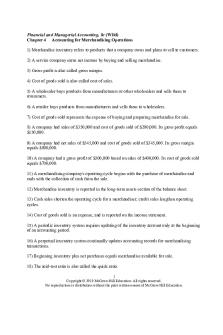
Wild8e chapter 04 tb - Notes
- 63 Pages

Wild8e chapter 05 tb - Notes
- 50 Pages

Wild8e chapter 03 tb
- 78 Pages
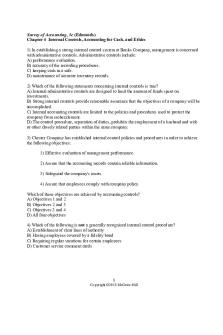
Edmonds 5e Chapter 04 TB
- 14 Pages

Spilker 10e Chapter 04 TB
- 18 Pages

04 horng acct11c tb 04
- 106 Pages
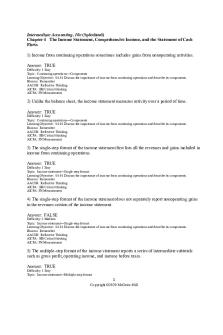
Spiceland 10e TB Chapter 04 Final
- 105 Pages
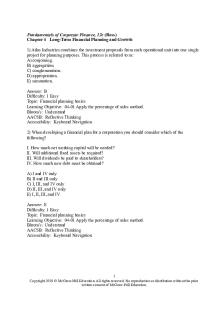
Ross12e Chapter 04 TB Answer Key
- 56 Pages
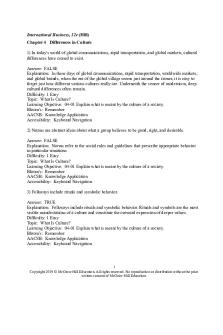
Hill12e Chapter 04 TB Answer Key
- 50 Pages
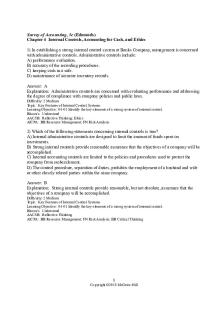
Edmonds 5e Chapter 04 TB Answer Key
- 33 Pages

0000001443 cnt-2019-04-04 guia-tb
- 68 Pages

Chapter 04
- 32 Pages

Chapter 04
- 13 Pages
Popular Institutions
- Tinajero National High School - Annex
- Politeknik Caltex Riau
- Yokohama City University
- SGT University
- University of Al-Qadisiyah
- Divine Word College of Vigan
- Techniek College Rotterdam
- Universidade de Santiago
- Universiti Teknologi MARA Cawangan Johor Kampus Pasir Gudang
- Poltekkes Kemenkes Yogyakarta
- Baguio City National High School
- Colegio san marcos
- preparatoria uno
- Centro de Bachillerato Tecnológico Industrial y de Servicios No. 107
- Dalian Maritime University
- Quang Trung Secondary School
- Colegio Tecnológico en Informática
- Corporación Regional de Educación Superior
- Grupo CEDVA
- Dar Al Uloom University
- Centro de Estudios Preuniversitarios de la Universidad Nacional de Ingeniería
- 上智大学
- Aakash International School, Nuna Majara
- San Felipe Neri Catholic School
- Kang Chiao International School - New Taipei City
- Misamis Occidental National High School
- Institución Educativa Escuela Normal Juan Ladrilleros
- Kolehiyo ng Pantukan
- Batanes State College
- Instituto Continental
- Sekolah Menengah Kejuruan Kesehatan Kaltara (Tarakan)
- Colegio de La Inmaculada Concepcion - Cebu


